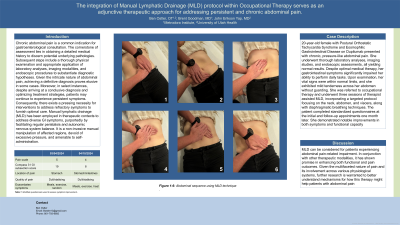Sunday Poster Session
Category: Functional Bowel Disease
P0651 - The Integration of Manual Lymphatic Drainage (MLD) Protocol Within Occupational Therapy Serves as an Adjunctive Therapeutic Approach for Addressing Persistent and Chronic Abdominal Pain
Sunday, October 27, 2024
3:30 PM - 7:00 PM ET
Location: Exhibit Hall E

Has Audio
- BO
Ben Ostler
Metrodora
Sandy, UT
Presenting Author(s)
Ben Ostler, 1, Brent Goodman, MD2, John Erikson Yap, MD, MBA, FACG3
1Metrodora, Sandy, UT; 2Metrodora, West Valley City, UT; 3Metrodora Institute, West Valley City, UT
Introduction: Chronic abdominal pain is a common indication for gastroenterological consultation. The cornerstone of assessment lies in obtaining a detailed medical history to discern potential underlying pathologies. Subsequent steps include a thorough physical examination and appropriate application of laboratory analyses, imaging modalities, and endoscopic procedures to substantiate diagnostic hypotheses. Given the intricate nature of abdominal pain, achieving a definitive diagnosis proves elusive in some cases. Moreover, in select instances, despite arriving at a conclusive diagnosis and optimizing treatment strategies, patients may continue to experience persistent symptoms. Consequently, there exists a pressing necessity for interventions to address refractory symptoms to furnish optimal care. Manual lymphatic drainage (MLD) has been employed in therapeutic contexts to address diverse GI symptoms, purportedly by facilitating regular peristalsis and autonomic nervous system balance. It is a non-invasive manual manipulation of affected regions, devoid of excessive pressure, and amenable to self-administration.
Case Description/Methods: A 20-year-old female with Postural Orthostatic Tachycardia Syndrome and Eosinophilic Gastrointestinal Disease on Dupilumab presented with chronic, pressure-like abdominal pain. She underwent thorough laboratory analyses, imaging studies, and endoscopic assessments, all yielding normal results. Despite optimal medical therapy, her gastrointestinal symptoms significantly impaired her ability to perform daily tasks.
Upon examination, her vital signs were within normal limits, and she exhibited mild tenderness across her abdomen without guarding. She was referred to occupational therapy and underwent three sessions of therapist assisted MLD, incorporating a targeted protocol focusing on the neck, abdomen, and viscera, along with diaphragmatic breathing techniques. The patient completed standardized questionnaires at the initial and follow-up appointments one month later. She demonstrated notable improvements in both symptoms and functional capacity.
Discussion: MLD can be considered for patients experiencing abdominal pain-related impairment. In conjunction with other therapeutic modalities, it has shown promise in enhancing both functional and pain outcomes. Given the multifaceted nature of pain and its involvement across various physiological systems, further research is warranted to better understand mechanisms for how this therapy might help patients with abdominal pain.

Note: The table for this abstract can be viewed in the ePoster Gallery section of the ACG 2024 ePoster Site or in The American Journal of Gastroenterology's abstract supplement issue, both of which will be available starting October 27, 2024.
Disclosures:
Ben Ostler, 1, Brent Goodman, MD2, John Erikson Yap, MD, MBA, FACG3. P0651 - The Integration of Manual Lymphatic Drainage (MLD) Protocol Within Occupational Therapy Serves as an Adjunctive Therapeutic Approach for Addressing Persistent and Chronic Abdominal Pain, ACG 2024 Annual Scientific Meeting Abstracts. Philadelphia, PA: American College of Gastroenterology.
1Metrodora, Sandy, UT; 2Metrodora, West Valley City, UT; 3Metrodora Institute, West Valley City, UT
Introduction: Chronic abdominal pain is a common indication for gastroenterological consultation. The cornerstone of assessment lies in obtaining a detailed medical history to discern potential underlying pathologies. Subsequent steps include a thorough physical examination and appropriate application of laboratory analyses, imaging modalities, and endoscopic procedures to substantiate diagnostic hypotheses. Given the intricate nature of abdominal pain, achieving a definitive diagnosis proves elusive in some cases. Moreover, in select instances, despite arriving at a conclusive diagnosis and optimizing treatment strategies, patients may continue to experience persistent symptoms. Consequently, there exists a pressing necessity for interventions to address refractory symptoms to furnish optimal care. Manual lymphatic drainage (MLD) has been employed in therapeutic contexts to address diverse GI symptoms, purportedly by facilitating regular peristalsis and autonomic nervous system balance. It is a non-invasive manual manipulation of affected regions, devoid of excessive pressure, and amenable to self-administration.
Case Description/Methods: A 20-year-old female with Postural Orthostatic Tachycardia Syndrome and Eosinophilic Gastrointestinal Disease on Dupilumab presented with chronic, pressure-like abdominal pain. She underwent thorough laboratory analyses, imaging studies, and endoscopic assessments, all yielding normal results. Despite optimal medical therapy, her gastrointestinal symptoms significantly impaired her ability to perform daily tasks.
Upon examination, her vital signs were within normal limits, and she exhibited mild tenderness across her abdomen without guarding. She was referred to occupational therapy and underwent three sessions of therapist assisted MLD, incorporating a targeted protocol focusing on the neck, abdomen, and viscera, along with diaphragmatic breathing techniques. The patient completed standardized questionnaires at the initial and follow-up appointments one month later. She demonstrated notable improvements in both symptoms and functional capacity.
Discussion: MLD can be considered for patients experiencing abdominal pain-related impairment. In conjunction with other therapeutic modalities, it has shown promise in enhancing both functional and pain outcomes. Given the multifaceted nature of pain and its involvement across various physiological systems, further research is warranted to better understand mechanisms for how this therapy might help patients with abdominal pain.

Figure: Figure 1 - 6: Abdominal sequence using MLD technique
Note: The table for this abstract can be viewed in the ePoster Gallery section of the ACG 2024 ePoster Site or in The American Journal of Gastroenterology's abstract supplement issue, both of which will be available starting October 27, 2024.
Disclosures:
Ben Ostler indicated no relevant financial relationships.
Brent Goodman indicated no relevant financial relationships.
John Erikson Yap indicated no relevant financial relationships.
Ben Ostler, 1, Brent Goodman, MD2, John Erikson Yap, MD, MBA, FACG3. P0651 - The Integration of Manual Lymphatic Drainage (MLD) Protocol Within Occupational Therapy Serves as an Adjunctive Therapeutic Approach for Addressing Persistent and Chronic Abdominal Pain, ACG 2024 Annual Scientific Meeting Abstracts. Philadelphia, PA: American College of Gastroenterology.
